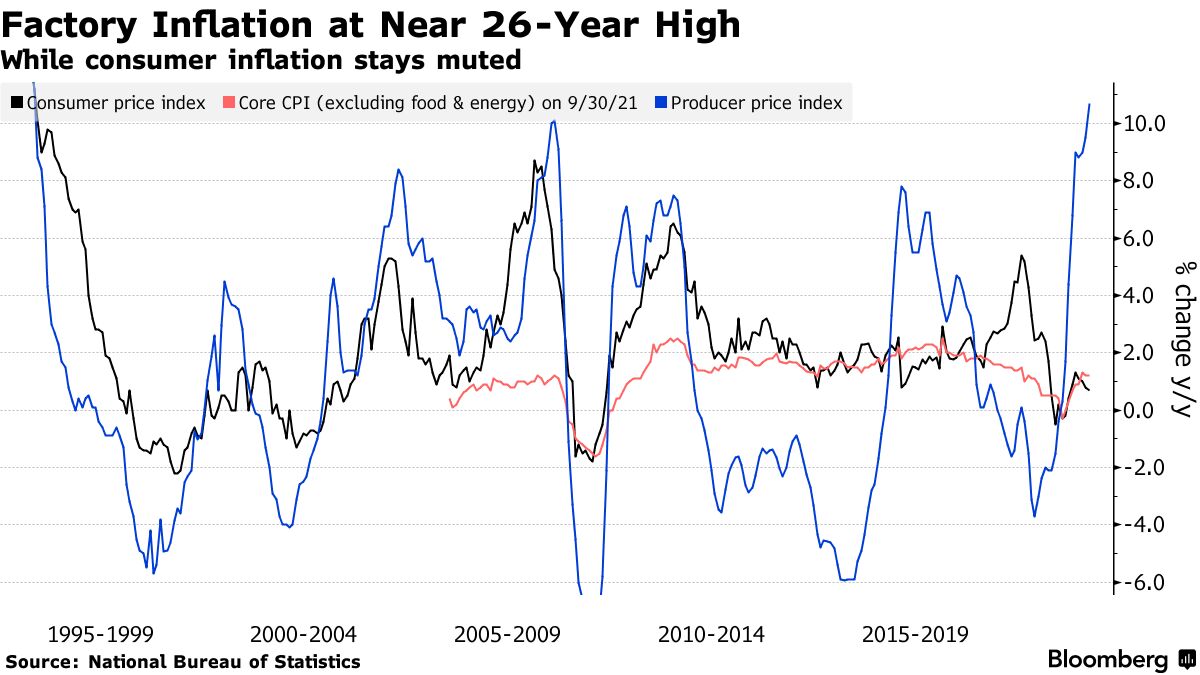super bullish ... for the phase-change from transient to persistent, that would tee-up regime-changes and that which can be valued, and I quote myself ....
"chaos is a gift, crisis is partner, volatility friend, lonely path right way, survive to survive again, let us pray before we prey"
particularly in glimmer of light Message 33528023 <<a <<Dark Side of China>>>>
In one aspect gold and crypto are exactly the same, in that each only needs to be correctly valued one in our life time.
bloomberg.com
China’s Factory-Gate Inflation Surges to Highest in 26 Years
14 October 2021, 10:39 GMT+8
China’s factory-gate prices grew at the fastest pace in almost 26 years in September, adding to global inflation risks and putting pressure on local businesses to start passing on higher costs to consumers.
The producer price index climbed 10.7% from a year earlier, the highest since November 1995, data from the National Bureau of Statistics showed Thursday. That exceeded the 9.5% gain in August and the 10.5% median estimate in a Bloomberg survey of economists.
The consumer price index rose 0.7% last month from a year earlier, lower than a 0.8% gain in the previous month.

The jump in PPI was mainly fueled by skyrocketing coal prices and other energy-intensive products, according to the NBS. Surging coal prices and policy goals to cut energy consumption have led to an electricity shortage, resulting in power rationing and factory production halts in over 20 provinces in September. Prices of other commodities such as crude oil also continued to climb, with the Bloomberg Commodity Index rising 5% for the month.
“The widened gap between PPI and CPI means greater pressure for upstream sectors to pass on rising costs to the downstream,” said Bruce Pang, head of macro and strategy research at China Renaissance Securities Hong Kong.
With coal futures at a record and the government allowing electricity prices to rise, inflation pressure will likely persist and start filtering through to consumers. Nomura Holdings Inc. estimates higher power prices could push up consumer inflation by 0.4 percentage point by the third quarter of 2022.
The gap between producer and consumer inflation increased in September to 10 percentage points from 8.7 points in August, the widest level since 1993.

There are early signs that producers are starting to pass on higher costs to consumers: the largest soy sauce maker in the country said this week it plans to raise retail prices of its products. At least 13 companies listed on China’s A-share market have announced price hikes this year to address rising costs and tight supply, China Securities Journal reported Thursday.
What Bloomberg Economics Says...The dramatic divergence in two key measures of China’s inflation -- with producer prices heating up further and consumer prices cooling in September -- highlights huge underlying strains in the economy. But for the central bank, the focus is on supporting growth. And lower CPI inflation gives it room for maneuver.
David Qu, China economist
For the full report, click here.
Higher inflation, coupled with a weakening economy, has raised concerns of stagflation in China, and created more uncertainty about the outlook for monetary policy easing. Many economists still expect the central bank to cut the reserve requirement ratio for banks to help spur liquidity in the economy.
“We think the risk of stagflation is rising in China as well as the rest of the world,” said Zhang Zhiwei, chief economist at Pinpoint Asset Management Ltd. “Persistent inflationary pressure limits the potential scope of monetary policy easing.”
Bonds were little changed after the data, with the yield on the benchmark 10-year government bond remaining at 2.95%.
For now consumer inflation remains in check because of falling pork prices, even though the removal of most virus controls by the end of September may have helped to boost household spending.
Other key details:
The food price index dropped 5.2% from a year ago, slumping for the fourth month Non-food CPI climbed 2% from a year ago, slightly above the 1.9% gain in AugustCore CPI, which strips out volatile items such as food and energy, was unchanged at 1.2%— With assistance by John Liu, Yujing Liu, and James Mayger
(Updates with comments from economists.)
Before it's here, it's on the Bloomberg Terminal.
LEARN MORE |






